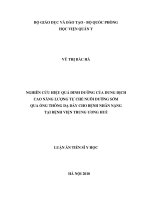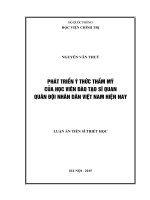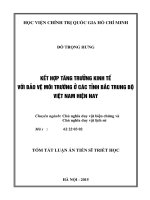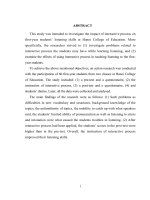Luận án tiến sĩ tương tác cặp đôi trong hoạt động nói của sinh viên cao đẳng ngành tiếng anh tại việt nam
Bạn đang xem bản rút gọn của tài liệu. Xem và tải ngay bản đầy đủ của tài liệu tại đây (2.52 MB, 244 trang )
MINISTRY OF EDUCATION AND TRAINING
HUE UNIVERSITY
UNIVERSITY OF FOREIGN LANGUAGES
VÕ THỊ KHÁNH LINH
PEER INTERACTION IN SPEAKING TASKS BY EFL
COLLEGE STUDENTS IN VIETNAM
DOCTOR OF PHILOSOPHY THESIS IN THEORY AND
METHODOLOGY OF ENGLISH LANGUAGE TEACHING
HUE, 2020
MINISTRY OF EDUCATION AND TRAINING
HUE UNIVERSITY
UNIVERSITY OF FOREIGN LANGUAGES
VÕ THỊ KHÁNH LINH
PEER INTERACTION IN SPEAKING TASKS BY EFL
COLLEGE STUDENTS IN VIETNAM
DOCTOR OF PHILOSOPHY THESIS IN THEORY AND
METHODOLOGY OF ENGLISH LANGUAGE TEACHING
CODE: 9 14 01 11
SUPERVISOR:
Assoc. Prof. LÊ PHẠM HOÀI HƯƠNG, PhD
HUE, 2020
BỘ GIÁO DỤC VÀ ĐÀO TẠO
ĐẠI HỌC HUẾ
TRƯỜNG ĐẠI HỌC NGOẠI NGỮ
VÕ THỊ KHÁNH LINH
TƯƠNG TÁC CẶP ĐÔI TRONG HOẠT ĐỘNG NÓI CỦA
SINH VIÊN CAO ĐẲNG CHUYÊN NGÀNH TIẾNG ANH
TẠI VIỆT NAM
LUẬN ÁN TIẾN SĨ
LÝ LUẬN VÀ PHƯƠNG PHÁP DẠY HỌC BỘ MÔN TIẾNG ANH
HUẾ, NĂM 2020
BỘ GIÁO DỤC VÀ ĐÀO TẠO
ĐẠI HỌC HUẾ
TRƯỜNG ĐẠI HỌC NGOẠI NGỮ
VÕ THỊ KHÁNH LINH
TƯƠNG TÁC CẶP ĐÔI TRONG HOẠT ĐỘNG NÓI CỦA
SINH VIÊN CAO ĐẲNG CHUYÊN NGÀNH TIẾNG ANH
TẠI VIỆT NAM
LUẬN ÁN TIẾN SĨ
LÝ LUẬN VÀ PHƯƠNG PHÁP DẠY HỌC BỘ MÔN TIẾNG ANH
MÃ SỐ: 9 14 01 11
HƯỚNG DẪN KHOA HỌC:
PHĨ GIÁO SƯ TIẾN SĨ LÊ PHẠM HỒI HƯƠNG
HUẾ, NĂM 2020
i
DECLARATION
I declare that this thesis is my own work. The data in my work is authentic, genuine
and correct.
i
ACKNOWLEDGEMENTS
I would like to express my sincerest and deepest gratitude to my supervisor,
Associate Professor Doctor Le Pham Hoai Huong for her great insights,
constructive feedback, precious suggestions, continuous encouragement and longlasting patience. She has put all of her heart and mind to support me, understood my
difficulties, sympathised my circumstances and accompanied me to the end of the
PhD journey. I admire her optimist spirit and attitudes toward scientific work and
learn from her how to make balance of life and work. It is my honour to be her
student and without her invaluable guidance and scholarly advice, I could not
complete this PhD journey.
I would like to thank the lecturers at Hue University of Foreign Languages
for their instructional advice and practical suggestions to different stages of my
thesis completion. The members of the panels, including Assoc. Prof. Pham Thi
Hong Nhung, Assoc. Prof. Tran Van Phuoc, Assoc. Prof. Truong Vien, Dr. Ton Nu
Nhu Huong, Dr. Bao Kham, Dr. Truong Bach Le, Dr. Pham Hong Anh, Dr. Nguyen
Ho Hoang Thuy, Dr. Tran Quang Ngoc Thuy and Dr. Nguyen Van Huy, have
insightfully given me suggestions to enhance the quality of the thesis.
I would like to acknowledge those students who agreed to participate in the
study. I am grateful for their time and efforts to complete the speaking tasks, write
learning diaries and join the interviews. Without their devotion and willingness to
share their work, experiences and thoughts with me, I could not have achieved my
academic purposes.
I also owe many thanks to my colleagues, Nguyen Hoang Mai Thy, Doan
Thi Thu Hien and Tran Thi Phuong Dung for their generous assistance of
instructing the students, transcribing the speaking tasks, coding the data and
translating the interviews. Their ongoing support concerning the study contributed
to my success.
I am particularly indebted to my parents, my mother-in-law, my husband and
my three daughters for their understanding, support and compassion throughout the
years of study. Without the constant support of my parents and my mother-in-law in
ii
taking care of, driving and getting my children to schools and back, I hardly
complete my PhD journey. My heartfelt gratitude also goes to my husband for his
spiritual support and empathy for my hard work and sometimes my irritation when I
got stuck with the study. I would like to express my special thanks to my three
daughters, Khanh Phuong, Khanh Lam and Linh Dan, for becoming more
independent of their learning and tolerant of my various times of absence from
home. The love and encouragement of my family gave me strength and
determination to complete the study.
iii
ABSTRACT
Drawing on Sociocultural Theory (SCT) as a theoretical framework, this
study investigated peer interaction in EFL context in Vietnam in which thirty
English-major students work with their partners to complete two speaking activities:
A decision-making task and a picture difference task. The study addresses four
questions (1) how EFL students interact in decision-making and picture difference
tasks, (2) what interaction patterns emerge from decision-making and picture
difference tasks by EFL students, (3) what students perceive to learn from peer
interaction in decision-making and picture difference tasks and, (4) what challenges
students face in interaction with peers in decision-making and picture difference
tasks. In order to gather qualitative and quantitative data for analysis, the study uses
different research tools, namely transcripts of video recordings of English-major
students completing two speaking tasks of decision-making and picture difference,
transcripts of semi-structured interviews with individual students after two task
completion and learning diaries written by each student after each speaking task.
The findings reveal that EFL students interact with their peers in English
speaking tasks in three forms of talk, namely cumulative, exploratory and
disputational, in line with Mercer’s (2004) results. The study also identified four
different patterns of interaction with different levels of equality and mutuality,
namely collaborative, expert/novice, dominant/passive and dominant/dominant,
similarly to Storch’s (2001) findings. Importantly, the types of talk and interaction
patterns are changeable and varied from each speaking task, which means that task
types decide the fluidity of the talk types and interaction patterns. Moreover,
students in the study reflect to learn from their partners and the task implementation
in terms of lexis, structures, pronunciation and intonation with the learning benefits
focusing on lexis and structures than pronunciation and intonation. Finally, EFL
students also deal with some problems concerning their linguistic abilities and
psychological factors during interacting with their peers to complete two tasks.
iv
LIST OF ABBREVIATIONS
EFL
English as Foreign Language
ESL
English as Second Language
FL
Foreign Language
IRF
Initiation-response-feedback
L1
First Language
L2
Second Language
L-L
Learner-Learner
NNSs
Non-native Speakers
PI
Peer interaction
S
Student
SCT
Sociocultural Theory
SDA
Sociocultural Discourse Analysis
SLA
Second Language Acquisition
TL
Target Language
ZPD
Zone of Proximal Development
v
TABLE OF CONTENTS
DECLARATION ......................................................................................................... i
ACKNOWLEDGEMENTS ........................................................................................ii
ABSTRACT ............................................................................................................... iv
LIST OF ABBREVIATIONS ..................................................................................... v
TABLE OF CONTENTS ........................................................................................... vi
LIST OF TABLES ..................................................................................................... xi
LIST OF FIGURES...................................................................................................xii
CHAPTER 1. INTRODUCTION ............................................................................... 1
1.1 Background of the Study ...................................................................................1
1.2 Rationale of the Study .......................................................................................2
1.3 Purpose of the Study ..........................................................................................4
1.4 Questions of the Study .......................................................................................4
1.5 Scope of the Study .............................................................................................4
1.6 Significance of the Study ...................................................................................5
1.7 Structure of the Study ........................................................................................6
CHAPTER 2. LITERATURE REVIEW .................................................................... 7
2.1 Sociocultural Theory Perspective of Interaction ...............................................7
2.1.1 Sociocultural Theory and Language Learning ...........................................7
2.1.2 Interaction and Peer Interaction in Sociocultural Theory ..........................9
2.1.3 Zone of Proximal Development and Peer Interaction ..............................14
2.1.4 Mediation and Peer Interaction ................................................................15
2.1.5 Scaffolding and Peer Interaction ..............................................................18
2.1.6 Communication Tasks for PI from Sociocultural Theory .........................21
2.2 Interaction and Foreign Language Learning ...................................................24
vi
2.2.1 Interaction and PI in Language Learning.................................................24
2.2.1.1 Interaction ..............................................................................................24
2.2.1.2 Importance of Interaction in Language Learning ..................................25
2.2.1.3 PI in Language Learning .......................................................................27
2.2.2 Interaction Patterns ...................................................................................30
2.2.3 Speaking Tasks for Language Learning ....................................................33
2.2.3.1 Speaking Tasks .......................................................................................33
2.2.3.2 Factors Influencing Oral Peer Interaction During Task Completion
Process ...............................................................................................................35
2.3 Previous Studies and Gaps in the Literature ....................................................38
2.4 Summary ..........................................................................................................40
CHAPTER 3. METHODOLOGY ............................................................................ 41
3.1 Research Approach and Research Design .......................................................41
3.2 Research Setting and Sample...........................................................................42
3.2.1 Research Setting ........................................................................................42
3.2.2 Participants ...............................................................................................42
3.2.3 The Researcher’s Role...............................................................................44
3.2.4 Tasks ..........................................................................................................44
3.2.4.1 Decision-making Task ............................................................................46
3.2.4.2 Picture Difference Task ..........................................................................47
3.3 Data Collection Methods .................................................................................47
3.3.1 Research Triangulation .............................................................................47
3.3.2 Instruments of Data Collection .................................................................48
3.3.2.1 Video-Recordings ...................................................................................48
3.3.2.2 Interviews ...............................................................................................49
vii
3.3.2.3 Learning Diaries ....................................................................................50
3.4 Data Collection Procedures .............................................................................51
3.5 Pilot Study........................................................................................................52
3.6 Data Analysis ...................................................................................................53
3.6.1 Sociocultural Discourse Analysis ..............................................................55
3.6.2 Interaction Patterns ...................................................................................60
3. 7 Summary of the Research Methods ................................................................67
3.8 Ethical Considerations .....................................................................................68
3.9 Research Validity and Reliability ....................................................................69
3.10 Summary ........................................................................................................70
CHAPTER 4. FINDINGS AND DISCUSSION....................................................... 71
4.1 EFL Students’ Interaction in Speaking Tasks .................................................71
4.1.1 The Types of Talk ......................................................................................71
4.1.1.1 Cumulative Talk .....................................................................................73
4.1.1.2 Exploratory Talk.....................................................................................74
4.1.1.3 Disputational Talk ..................................................................................75
4.1.1.4 The Fluidity of Talk Types ......................................................................76
4.1.2 Interaction Features in PI through Speaking Tasks..................................77
4.1.2.1 Scaffolding in PI through Speaking Tasks .............................................77
4.1.2.2 Mediation in PI through Speaking Tasks ...............................................82
4.1.3 Discussion .................................................................................................88
4.2 EFL Students’ Interaction Patterns in Speaking Tasks ...................................92
4.2.1 Interaction Patterns ...................................................................................92
4.2.1.1 Collaborative Pattern .............................................................................94
4.2.1.2 Expert/Novice Pattern ............................................................................97
viii
4.2.1.3 Dominant/Passive Pattern ......................................................................98
4.2.1.4 Dominant/Dominant Pattern ................................................................100
4.2.2 The Fluidity of Interaction Patterns and Changeable Roles of Peers ....101
4.2.3 Discussion ...............................................................................................106
4.3 EFL Students’ Learning in Speaking Tasks ..................................................109
4.3.1 Reported Language Learning in PI .........................................................109
4.3.1.1 Reported Knowledge Co-construction .................................................109
4.3.1.2 Reported Language Use .......................................................................112
4.3.1.3 Reported Skills and Strategies Use ......................................................114
4.3.2 Discussion ...............................................................................................118
4.4 EFL Students’ Challenges in PI in Speaking Tasks ......................................120
4.4.1 Challenges in Peer Interaction ...............................................................120
4.4.1.1 Linguistic Difficulties ...........................................................................120
4.4.1.2 Negative Psychological Factors ...........................................................124
4.4.2 Discussion ...............................................................................................127
4.5 Summary ........................................................................................................129
CHAPTER 5. CONCLUSION AND IMPLICATION ........................................... 130
5.1 Key Findings and Conclusion ........................................................................130
5.2 Contributions of the Study .............................................................................133
5.3 Implication .....................................................................................................135
5.4 Limitations of the Study ................................................................................137
5.5 Suggestions for Future Studies ......................................................................138
LIST OF AUTHOR’S WORKS.............................................................................. 139
REFERENCES ........................................................................................................ 140
APPENDIX A: SUMMARY OF PREVIOUS STUDIES ...................................152
ix
APPENDIX B: SCORES OF PARTICIPANTS’ SPEAKING SKILLS AND
THEIR SPEAKING COMPETENCE BEFORE THE STUDY..........................163
APPENDIX C: DECISION-MAKING TASK ....................................................166
APPENDIX D: PICTURE DIFFERENCE TASK ..............................................167
APPENDIX E: INTERVIEW QUESTIONS ......................................................168
APPENDIX F: LEARNING DIARY .................................................................169
APPENDIX G: CONSENT FORM FOR PARTICIPANTS ...............................172
APPENDIX H: TRANSCRIPTION CONVENTIONS ......................................173
APPENDIX I: EXCERPTS FROM TRANSCRIPTIONS ..................................174
APPENDIX J: INTERVIEW AND LEARNING DIARY CODING .................189
APPENDIX K: LIST OF LINGUISTIC FEATURES LEARNT BY STUDENTS
.............................................................................................................................193
APPENDIX L: SAMPLE ANALYSIS OF MERCER’S TYPOLOGY BASED
ON SCAFFOLDING TECHNIQUES .................................................................200
APPENDIX M: SAMPLE TRANSCRIPT OF PAIR INTERACTION IN EACH
SPEAKING TASK ..............................................................................................211
APPENDIX N: SAMPLE TRANSCRIPT OF INTERVIEW AND CODING OF
THE INTERVIEW ..............................................................................................219
APPENDIX O: SAMPLE OF STUDENT LEARNING DIARY AND CODING
OF THE LEARNING DIARY ............................................................................222
x
LIST OF TABLES
Table 3.1. Classification of Types of Talk ............................................................... 55
Table 3.2. Category of Scaffolding Means ............................................................... 58
Table 3.3. Functions of L1 ........................................................................................ 59
Table 3.4. Patterns of Interaction with Indicators of Mutuality and Equality .......... 61
Table 3.5. Categories of Initiation-Response-Feedback ........................................... 64
Table 3.6. Summary of the Research Methods ......................................................... 67
Table 4.1. Types of Talk across Two Tasks ............................................................. 71
Table 4.2. Scaffolding Techniques used in Decision-making Task.......................... 77
Table 4.3. Scaffolding Techniques used in Picture Difference Task ........................ 79
Table 4.4. The Functions of L1 across Two Tasks ................................................... 83
Table 4.5. Patterns of Interaction across Two Tasks ................................................ 92
Table 4.6. I-R-F used in Decision-making Task ..................................................... 102
Table 4.7. I-R-F used in Picture Difference Task ................................................... 103
xi
LIST OF FIGURES
Figure 2.1. Patterns of interaction (Storch, 2001, p.113) ......................................... 30
Figure 4.1. Comparison of Talk Types across Two Speaking Tasks ........................ 72
Figure 4.2. Comparison of L1 Functions across Two Tasks .................................... 85
Figure 4.3. Comparison of Total Turns across Two Tasks ....................................... 87
Figure 4.4. Comparison of Interaction Patterns across Two Speaking Tasks .......... 93
Figure 4.5. Reported Knowledge Co-construction ................................................. 110
Figure 4.6. Reported Language Use ........................................................................ 113
Figure 4.7. Reported Language Skills Use ............................................................. 115
Figure 4.8. Reported Linguistic Difficulties ........................................................... 120
xii
CHAPTER 1. INTRODUCTION
INTRODUCTION
The current study investigates peer interaction in speaking tasks by EFL
college students at a teachers’ training college in central Vietnam. This chapter
introduces the background of the study and statement of the problem, presents the
research purpose and research questions. It also provides an overview of the
research significance and describes the organization of the thesis.
1.1 Background of the Study
Nowadays, the role of interaction especially PI is prioritised in language
setting because it provides context for language learning in which learners
experiment with language, receive feedback, modify their language (Philp, Adams,
& Iwashita, 2014), and co-construct language knowledge (De Guerrero & Villamil,
2000; Donato, 1994; Ohta, 2001; Swain & Lapkin, 1998). In essence, language
learners construct their knowledge and develop their target language (TL) through
interaction with others in the learning environment. Thus, a large body of current
interaction-based research has been conducted in language classroom settings with
participants of adult learners in PI (Nguyễn Thu Hiền, 2017). The literature of PI,
then, has been widened with the claim of promoting L2 learning on different aspects
of target language features and skills (e.g., grammar, vocabulary, pronunciation and
writing skill). In addition, research has examined the collaborative nature of PI,
which promotes language learning (Donato, 1994; Storch, 2001; Swain & Lapkin,
1998).
However, while various interaction-based studies assert the advantages of PI
in different aspects of language learning and teaching, there is a scarcity of research
on interaction patterns, its influence and its association with language development
in various EFL settings, specifically in speaking skill context. Therefore, an
increasing number of EFL learning studies focusing more on the social nature of
learning have been done to investigate PI to answer the questions of how the peers
interact, the roles of interactants, the peers’ proficiency, the impacts of PI on
1
language development, the types of interaction patterns more conducive to language
learning and even the challenges peers encounter in various language settings.
1.2 Rationale of the Study
In the age of globalisation, English has played an important role as an
international language and has a crucial position in the teaching and learning in
schools in Vietnam. The crucial role of mastering a foreign language in the modern
society has been underpinned by the government, researchers, managers and
teachers in the schools. A great amount of language-in-education policies has been
promulgated to confirm the role of foreign language including English in the
schools and society. The National Foreign Language project 2020 was initiated with
the aim to renovate the teaching and learning of foreign languages within the
national education system. This long-term project managed by the MOET aims to
develop the English capacity of its workforce and increase their ability to engage in
a globalized world. In order to achieve the aim of English competence in secondary
and vocational schools, colleges and universities, Vietnamese teachers and
researchers have put the emphasis on exploring new approaches to make English
language teaching and learning in Vietnam more relevant, efficient, and productive.
Over the past decades, language teachers and learners in EFL and ESL contexts
have witnessed the shift of language methodology from teacher-centeredness to
learner-centeredness. In this case, PI is considered as an appropriate solution for
maximizing learner’s initiative in language learning. With the purposes of
enhancing learners’ initiatives in learning TL, more and more classroom activities
are designed so that language learners have opportunities to work with their peers in
communicative tasks in Vietnam. In fact, English is a foreign language in Vietnam
so most learners’ oral interactions in English occur within the classrooms only.
Even though communicative activities are emphasised in language classrooms to
create more learning opportunities for EFL learners to interact in English,
Vietnamese students still encounter problems in communicating in English
effectively. This happens to majority of EFL learners, and even with English-major
students. With more than fourteen-year experience teaching English in a teachers’
2
training college, I have also noticed the same communicative problems with
English-major students. Thus, there is a need to understand how students actually
use language to communicate in the classrooms in order to support them to make
full use of the potential of PI within the classrooms, in order to enhance English
language fluency.
Regarding peers and relationships of peers, studies on nature of L2 learning
through PI can be asymmetrical and symmetrical. Investigation into top-down and
one-way working with peers is more popular, specifically interaction between
teacher and learners (Nguyễn Thu Hiền, 2017) while a comprehensive
understanding of how EFL students respond to their peers of similar background is
still needed more contribution. As such, the unbalancing focus of interaction-based
research in Vietnam tertiary level is on the unsymmetrical relationship of peers (e.g.
Lê Phạm Hoài Hương, 2007; Phạm Ngọc Thạch, 2015; Trần Thị Thanh Thương &
Lê Phạm Hoài Hương, 2017). Understanding how Vietnamese learners of similar
background with similar and different language proficiency actually interact using
English when working together in pairs in EFL speaking contexts contributes to the
literature of PI and its association with language learning.
Moreover, the association between PI and development of specific linguistic
features and of language skills is found in varied EFL contexts. However, PI in
English speaking tasks in Vietnamese tertiary contexts is still under-investigated.
The questions of PI by EFL college students in Vietnam implementing PI through
speaking tasks are left unanswered. As a result, in order to improve Vietnamese
learners’ English language learning through oral discussions, a comprehensive
study on how learners actually use English to communicate with their peers during
classroom activities is needed. In particular, it is important to investigate how
learners use the English language to conduct discussions, to negotiate meaning and
to display attitudes towards other learners and the task. This study aims to gain a
better understanding of language use in speaking tasks among Vietnamese EFL
college students.
3
1.3 Purpose of the Study
The current study focuses on the practice of PI in the theoretical framework
of SCT. The primary purpose of this study is to investigate the way Vietnamese
EFL college students interact in English speaking tasks in pairs. The study also aims
to explore the interaction patterns that are produced through PI and to clarify the
linguistic benefits and the knowledge construction the students might gain from
working together. The final aim is to identify the challenges these students deal with
during completing the peer speaking tasks.
1.4 Questions of the Study
a) How do EFL college students interact in decision-making and picture difference
tasks?
b) What interaction patterns emerge from decision-making and picture difference
tasks done by EFL college students?
c) What do the students perceive to learn from peer interaction in decision-making
and picture difference tasks?
d) What challenges do the students face in interaction with peers in decisionmaking and picture difference tasks?
1.5 Scope of the Study
The study focuses on exploring PI of EFL students in Vietnam when they
complete the English speaking tasks. It investigates the ways EFL students interact
in different types of talk as well as the language techniques they manipulate to
implement the speaking tasks with their partners. The study also focuses on looking
into the interaction patterns they produce on conducting the English speaking tasks.
Additionally, the learning benefits they gain from task completion and the
challenges they encounter during PI are researched. The main focus of the PI
process in the study is on verbal interaction due to the advantages and undeniable
role of spoken words in communication. Non-verbal interaction such as gestures or
facial expressions during peer speaking tasks will not be recorded for analysis.
Moreover, as it is stated in the research objectives, this study neither focuses on the
reasons why peers interact in certain patterns but looks for the patterns nor
4
investigates the relationship between interaction patterns and the outcomes. This
study does not either aim to investigate personalities of the participants as it focuses
more the interactions between peers.
The study is conducted at a national college of education with the
participation of second-year students of English majors mainly from rural and
highland areas of the central areas of Vietnam. Findings of the study therefore,
cannot be generated to other contexts of EFL speaking classes like those in urban
universities in Vietnam or in other countries.
1.6 Significance of the Study
It is hoped that the study findings are valuable in contributing to
understandings of English classroom learning in both theoretical and pedagogical
aspects. Theoretically, it provides additional literature of SCT’s view of the social
nature of learning and extends the base of sociocultural research on PI to EFL
college students in Vietnam. Specifically, the findings of the study contributes to
knowledge of the way EFL college students interact with their peers in symmetrical
relationship of relatively similar language proficiency from SCT perspectives.
Additionally, evidence of the nature of peer talk and its route of talk type fluidity
imply practical principles for peer language learning in Vietnamese tertiary
contexts. EFL learners and language teachers can utilise this insight as driving
inspiration to design and organise learning activities in forms of pair work.
In addition to exploring PI drawing on sociocultural theory, the study also
investigates patterns of PI with the use of Storch’s (2001, 2002) typology to
understand types of PI, together with the mutuality and equality of Vietnamese adult
EFL students on conducting speaking tasks. This includes the combination of
interaction patterns in different speaking tasks. The findings of the study may also
inform EFL teachers of different interaction patterns and the changes of the patterns
that language learners may manipulate. The data of PI processes in the study may
provide classroom teachers with practical knowledge of PI to apply in their teaching
practices. Pedagogically, this study yields insights for language teachers in general
5
and English language teachers in particular in training, especially in speaking tasks,
to make classroom interaction a rich environment conducive to FL/L2 learning.
Furthermore, the study seeks the learning benefits and challenges of PI in
speaking tasks. Practically, the findings of association between these and language
outcomes add to the understanding of what peers may gain from working
collaboratively and what affective factors may discourage language learning
development. Consequently, language teachers in Vietnam and in other contexts
similar to Vietnam may have great consideration when they implement their
teaching activities.
The fact that this study is conducted on PI in speaking tasks contributes to
the largely neglected knowledge of interaction-based studies on speaking skills. In a
similar vein, it also contributes by exploring the relationship between task types,
specifically consensus tasks and interaction patterns or types of talk. The study,
therefore, sheds some light on how speaking tasks should be designed for the
conduciveness of language learning.
As applying two frameworks of SCT and Storch’s (2002) category in an
interaction-based research in tertiary context of speaking classes in Vietnam is still
rare, this study may motivate more educational researches using these frameworks
in other contexts to other language skills. Finally, this study hopes to shed some
light on English education programmes by prioritising language use, interaction and
learning in their agenda.
1.7 Structure of the Study
The study consists of five main parts, including Chapter 1: Introduction of
research rationale, questions, scope and significance; Chapter 2: Literature review
of overviews of the nature of PI and the theoretical background; Chapter 3:
Methodology of research approach, instruments, data collection procedures and
research methods; Chapter 4: Findings and discussion of answers for four research
questions with detailed discussion; Chapter 5: Conclusion and Implication of
summary of major findings and conclusions, the study contribution, pedagogical
implications study limitations and suggestions for future researches.
6
CHAPTER 2. LITERATURE REVIEW
LITERATURE REVIEW
The chapter provides the overviews of the theoretical background and
introduces the theoretical framework of SCT underpinning the current study. The
nature of PI in language learning from the perspectives of SCT for the deeper
understanding of the peer talks is detailed in two sections of the chapter.
2.1 Sociocultural Theory Perspective of Interaction
2.1.1 Sociocultural Theory and Language Learning
SCT was derived, in part, from the work of Russian psychologist Lev
Vygotsky (1978) and his colleagues. SCT explains the cognitive cycles of human
beings which originate from the social plane (at interpersonal level) and afterwards
are internalised in intrapsychological plane (at intrapersonal level, i.e. the mental
process). In other words, the theory describes learning and development as being
embedded within social events and occurring as a learner uses language to interact
with other people, object and events in the collaborative environment.
Subsequently, at the individual level, learners also use language as the key
mediational tool to support the cognitive development inside their minds to
construct the knowledge. In both social and individual levels, language plays a
primary role and thus is regarded as a powerful mediational tool. Consequently,
SCT maintains the relationship between social interaction and language learning
through which the knowledge is co-constructed because the higher mental functions
like problem solving, voluntary attention and logical memory are mediated (Lantolf
& Thorne, 2006; Watanabe, 2014) through the people’s interaction by the use of
mediational tools.
SCT is meaningful to language learning and development due to its concept
that human activities take place in cultural context, are mediated by language and
other symbol systems (Lê Phạm Hoài Hương, 2003). In other words, the focus on
the importance of language implies that “participation in culturally organized
activity is essential for learning to happen” (Lantolf & Thorne, 2006, p. 214).
Simply put, learning is socially and culturally mediated by language. In describing
7
the culturally constructed meaning, SCT followers use various key concepts among
which ZPD, mediation and scaffolding are the most relevant to this current study.
SCT not only focuses on the social, cultural and historical context of the
learners but also stresses the role of others (adults and peers) in the learning process.
The peers and their functions in the learning context are well conceived within
terms of ZPD and scaffolding with special criteria and characteristics for the
purpose of language development. Thus, this theory brings many instructional
implications to the classroom. In the case of learners taking part in the speaking
tasks, learners (peers of different proficiency) interact with each other by using
language (L1 and TL) and through the scaffolding process between the more
capable peer and less capable peer then the internalisation process inside their
minds, the language learning is mediated.
Three concepts of SCT, namely “that social interaction informs the
development and character of mental processes, that cultural tools mediate
psychological functioning, and that development advances through the ZPD”
(Lantolf & Thorne, 2006, p. 287), underpin various research on L2/FL learning by
providing the prompts of synthesis of these concepts, bringing together the ZPD
with social interaction and cultural tools. In other words, through the lens of SCT,
L2/FL learning and development are intervened by many effective factors in which
the use of language (L1 and L2) as a powerful symbolic mediational tool should
occur in the ZPD and through social interaction.
SCT is considered as a breakthrough from cognitive approach. While
cognitive approach focuses on the mental processes related to individual language
development emphasising individual cognition, cognitive processing, individual
performance and abilities measured in numbers, SCT considers cognitive
development originates in social interaction. SCT underscores
learners’
collaboration in building up the knowledge through the social interaction, the heart
of learning process. From SCT perspective, learning is viewed not as “products and
states” but as “changes and processes” (Schinke-Llano, 1995, p.22). The “changes
8
and processes” occur during the interaction learning context of the language
learners (peers) in their ZPD by the mediational tools through mutual scaffolding.
SCT prioritizes interaction in L2 learning because the “importance of
interaction for learning is an area of common ground for most perspectives on
language learning” (van Lier, 2000, p. 247), which results in the fact that interaction
has been a central concern of SLA research based on SCT. The importance of
interaction, especially PI, is also underpinned by SCT perspective because
“individual knowledge is socially and dialogically derived” (Donato, 1994, p. 51).
According to SCT, learning arises not through interaction but in interaction (Ellis,
2000). Learners first succeed in performing a new function with the assistance of
another person and then internalize this function so that they can perform it
unassisted. In this way, social interaction mediates learning (Ellis, 2000). Moreover,
Lantolf and Thorne (2006) underscore that PI should be included among learners in
classroom contexts where learning takes place. Various studies from SCT
perspective have shown how PI can scaffold and mediate language development,
providing guidance in students’ ZPD effectively though the use of various
interactive strategies or interaction patterns (e.g., Donato, 1994; Ohta, 2001).
Taken as a whole, SCT provides the key concepts for language learning with
the emphasis on social interaction in knowledge construction and the principles for
learners working together (PI) through the introduction of ZPD, mediation and
scaffolding which are intertwined and support one another to form the holistic
perspective of learning in general and language learning in particular. With the
focus on association of PI and language development, SCT is an appropriate
framework for the current study.
2.1.2 Interaction and Peer Interaction in Sociocultural Theory
The notion of “interaction” and its close connection with foreign language
learning have been demonstrated by the early research on NNSs development of L2
knowledge through interaction, especially with the introduction of Interaction
Hypothesis by Long (1996) emphasising the role of comprehensible input due to its
relation to language learning through interaction. Krashen’s (1985) seminal Input
9









